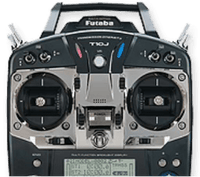Things You Might Not Be Doing (But Should)
von Todd BredaWhether you are just getting started in the hobby or have been flying R/C models for years there's always good practices, tips and tricks that come along that are worth knowing about and utilizing in your every day processes and procedures. Here are a few to consider. I will add more tips and tricks to this article as time passes.
Balancing Your Propeller
Consider this in the "mandatory" category. Not everyone balances their propellers but they should be. While some come from the factory already balanced, most are not and require balancing to avoid excessive vibration in flight. An unbalanced propeller can lead to vital parts of your model loosening and coming apart which could result in a crash.
Unbalanced propellers are notoriously noisy. This is almost always a sign that your propeller is out of balance. To balance your propeller you will want to invest in a propeller balancer. Dubro and Top Flite are good brands to consider.
Once you determine which blade is heavier than the other, you can add small pieces of tape (Gorilla Tape works great but many kinds of tape can be effective) to the back of the lighter blade. Once your propeller balances evenly on the balancer your prop is balanced and ready to be installed on your model.
Burning Through Your LiPos Is Fun. Burning Up Your LiPo's? Not So Much
One of the most vital steps in keeping your hobby as safe as possible is knowing how to properly store, charge and maintain your Lithium Polymer (LiPo) batteries. Doing so can be the difference between maximizing your battery's life or burning your house down.
Handling and Storing
- Keep LiPo battery packs well out of reach of children.
- Do not put battery packs in pockets or bags where they can short circuit.
- Do not store or transport batteries where they can come into contact with sharp or metallic objects.
- Do not store your LiPo pack in extreme temperatures below 0 °C (32 °F) or above 50 °C (122 °F).
- Always store your LiPo pack in a safe and non flammable container away from flammable objects. A LiPo Sack or metal / ceramic storage container is best.
- Always store your LiPo’s partially charged. They will maintain their performance levels over time and there’s no need to cycle them unless stored for periods longer than 3-6 months.
- Do not immerse the battery in water or allow the battery to get wet.
- Do not dispose of in fire or heat.
- When mailing or shipping LiPo batteries, always ship them at a 30% charged state for safety reasons.
- When storing batteries for extended periods, store at a half charged state.
- To dispose of a LiPo battery, discharge it fully then place it in a bucket of salt water for one week. To dispose of, follow your municipal battery disposal guidelines.
Charging
- Always use a charger made to charge LiPo packs.
- Double check that the settings for the lithium polymer charger are correct for the pack being charged. This includes the cell count, as well as the current settings. In general, most lithium polymer batteries should be charged to no more than 4.2 volts per cell or depleted to less than 3.0 volts per cell.
- Ensure that charging leads are connected correctly. Reverse charging can lead to cell damage or a fire or explosion.
- Always charge LiPo batteries on surfaces that won’t catch on fire such as cement, steel, ceramic or stone. Wooden tables and carpeted floors are not recommended charging surfaces.
- Do not charge batteries near flammable products or liquids.
- Never charge a LiPo battery while inside your model or other electronic device. If it catches fire it can lead to total destruction of the item it is being charged in.
- LiPo batteries should be charged within a temperature range of 0 °C (32 °F) to 50 °C (122 °F). Batteries charged outside this temperature range may experience leakage, heat generation or cell damage.
- Never leave a charging lithium polymer battery pack unattended.
- Do not charge inside an automobile, especially while driving.
- Do not store batteries inside an automobile.
- If unsure of the charge rating, never charge a lithium polymer battery pack at a rate over 1C (1 x the battery packs rated capacity).
- Never charge a LiPo pack that has ballooned or swelled (known as "puffed") due to over / under charging or from a crash.
- Never charge a lithium polymer battery pack that has been punctured or damaged in a crash.
- Never, under any circumstances let the positive and negative battery leads touch each other. It can lead to cell ballooning, cell damage or fire or an explosion.
- Have a fire extinguisher near the charging area or a large bucket of dry sand. Do not try to distinguish with water.
- If you notice your LiPo battery pack is swelling, stop the charging process immediately, put the battery in a safe container and observe it for 15 minutes.
- Always charge your Lipo battery packs in a Lipo charging safe bag such as the Dynamite LiPo Charge Protection Bag.
Throttle Lock
We've all heard the stories from flyers who in some way or another found themselves in a situation where they accidentally engaged the throttle on a live model and the propeller proceeded to rip into flesh or property without any time to react creating all kinds of unfortunate (and sometimes gruesome) damage.
Newer transmitters have throttle lock built in so all you have to do is activate it. If you own a transmitter that does not have throttle lock as a feature but has mixing capability this should be a mandatory step when programming any model. You will want to refer to your radio's instruction manual for the precise steps to program throttle lock. This is done by assigning the mix to the switch you want to use. That switch then becomes your "safety" switch which should always be activated whenever you turn your radio on and plug in your battery.

Hobby Squawk Community Forum
visit forum
RC Knowledge Blog
visit blog
Guidance & advice for beginners
Find out more- Wenn du eine Auswahl auswählst, wird eine vollständige Seite aktualisiert.
- Drücke die die Leertaste und dann die Pfeiltasten, um eine Auswahl zu treffen.
